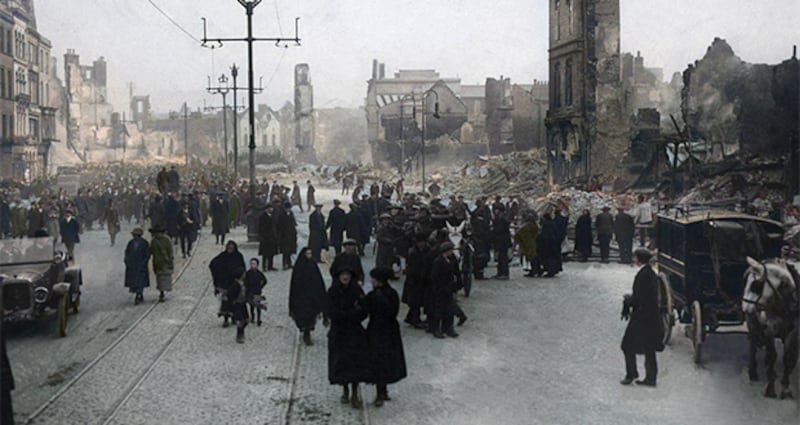Exactly a century ago, British prime minister David Lloyd George was getting irritated about Ireland. Events there were making a mockery of his bombastic claim made in early November 1920 at the lord mayor’s banquet in London that “We have murder by the throat”. Bloody Sunday, movingly and solemnly commemorated last week, took hardly a puff out of him and he had precious little sympathy for the slain British officers. Privately, he said: “They got what they deserved, beaten by counterjumpers . . . tragic as the events were in Dublin, they were of no importance. These men were soldiers and took a soldier’s risk.”Events the following week, however, were of a different order. The Kilmichael Ambush in west Cork, the centenary of which falls tomorrow, resulted in the IRA killing 17 Auxiliaries; it was the most notorious of the IRA’s ambushes during the War of Independence and precise details of the killings and their nature are disputed to this day.
Lloyd-George told his cabinet these killings were of a “different character” from previous IRA operations as rather than “assassination”, the Kilmichael assault “was a military operation and there was a good deal to be said for declaring a state of siege or promulgating martial law in that corner of Ireland”.
A way out

This duly happened for much of Munster, but there were simultaneous impulses to explore new options and Lloyd-George became more focused on the idea of a way out of the Irish quagmire. It took another eight months to achieve a truce, but the events of November were pivotal in changing attitudes.
The Kilmichael Ambush will be commemorated this weekend and those involved will seek, virtually, to mark its significance in the overall War of Independence and remember the three IRA men killed as a result of the ambush, including Patrick Deasy from Bandon, aged just 16, though I doubt they will be lighting candles for the fallen Auxiliaries, including 21 year old James Gleave from Worcester
The Kilmichael Ambush will be commemorated this weekend and those involved will seek, virtually, to mark its significance in the overall War of Independence and remember the three IRA men killed as a result of the ambush, including Patrick Deasy from Bandon, aged just 16, though I doubt they will be lighting candles for the fallen Auxiliaries, including 21 year old James Gleave from Worcester.
Last week unionist Nelson McCausland complained that the events planned to mark the centenary of Bloody Sunday were another example of “partial remembering”; so too, will be the Kilmichael events this weekend. Commemorations are nearly always about partial remembering; as Edna Longley remarked, they are “as selective as sympathies, they honour our dead, not your dead”. McCausland’s political family have likewise always practised their own versions of selective memorialisation.
But there are some forms of commemoration that are much more inclusive than others, none more so than the recently published book by Eunan O’Halpin and Daithí O Corráin, The Dead of the Irish Revolution, which, after almost 20 years in the making, finally provides an answer to a question asked for decades: how many people died as a result of political violence in Ireland between 1916 and 1921?
The answer is 2,850 and the book explores their backgrounds, why they died and who was responsible for their deaths. This book is about digging deep and trying to exhaust all research avenues rather than flag waving and it is a reminder of how many fell between the cracks of remembrance.
Headline killings
For all the headline killings on November 28th for example, there were others killed on the same day who were quickly forgotten, including Thomas Downing, a married ex-serviceman and telephonist who had been kidnapped a few days previously while going to a meeting of the Cork branch of the Federation of Demobilised Sailors and Soldiers. He was executed and buried at the Cork No 1 IRA brigade’s killing field at the Ray, Knockraha.
The Dead of the Irish Revolution is the War of Independence equivalent of Lost Lives by David McKittrick, covering the men, women and children killed during the Troubles in Northern Ireland and it too will be an indispensable reference work.
It is a scholarly, noble endeavour and a triumph of even-handed research in the midst of a decade of centenaries when it does not take much to open old wounds, as underlined at the beginning of this year in relation to commemoration of the RIC.
One thing that stands out from the compilation of fatalities is that what we choose to remember is not necessarily what made the most impact in relation to body count. For all the focus on ambushes – “the classic motif of the War of Independence”– fatalities arising from them accounted for just over a fifth of deaths, less than assassinations or executions. And for all the preoccupation with combatants, of 2,344 people who died due to political violence between January 1917 and December 1921, 919 or 39 per cent were civilians.
Britain, too, as revealed by Lloyd-George’s insensitive dismissiveness a century ago has its own selective hierarchy of remembrance. While it does much to mark the soldiers killed in the two world wars and proudly assembles at cenotaphs, it prefers to forget its murky wars in Ireland and those who fought them under the insignia of the crown.











